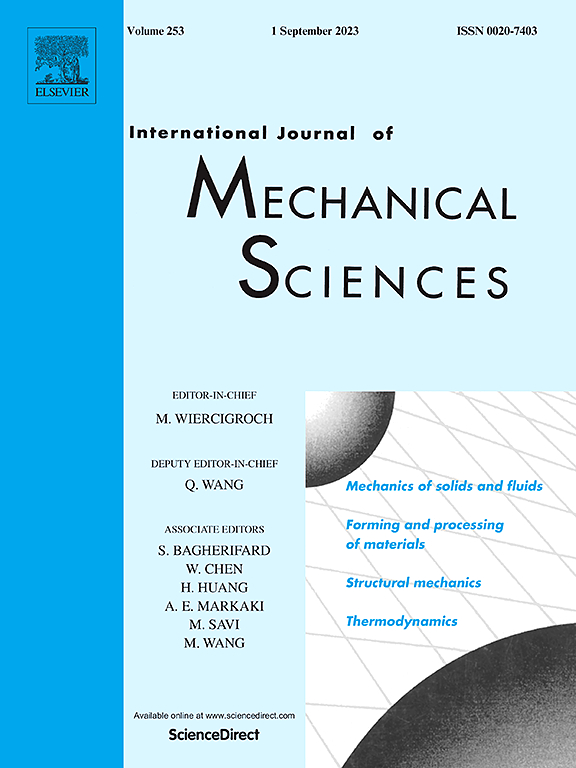Modeling and design of pre-set stiffness continuum robot
IF 7.1
1区 工程技术
Q1 ENGINEERING, MECHANICAL
International Journal of Mechanical Sciences
Pub Date : 2025-04-15
DOI:10.1016/j.ijmecsci.2025.110224
引用次数: 0
Abstract
Minimally Invasive Surgery (MIS) through human body cavities requires continuum robots to adapt to physiological structures while maintaining sufficient degrees of freedom for precise operations. However, their clinical adoption has been limited by complex flexible joints and actuation mechanisms. This paper proposes a Pre-set Stiffness Continuum Robot (PSCR), which employs a pair of geometrically optimized superelastic tubes with asymmetric patterns to create joint units of varied stiffness and maximum working angles, enabling pre-programmed motion trajectories. An integrated tendon structure enhances overall stiffness and bidirectional push–pull capabilities. Through mechanical analysis of a single joint unit, we established a quantitative relationship between tendon-driven force and global bending curvature, considering force balance and friction effects. This led to the derivation of mapping relationships among task space, mechanical space, kinematic space, and robot configuration, providing a theoretical foundation for motion behavior prediction. Experimental validation of a PSCR prototype confirmed its kinematic and mechanical models, stiffness, and load-bearing capacity. The single-tendon actuation PSCR enables partial extreme position locking for lumen adaptation while retaining the ability for further motion in its unlocked segments, allowing precise distal manipulation, which offers an efficient and accurate solution for MIS procedures.

预置刚度连续体机器人的建模与设计
通过人体腔体进行的微创手术(MIS)需要连续体机器人在适应生理结构的同时保持足够的自由度以进行精确手术。然而,它们的临床应用受到复杂的柔性关节和驱动机制的限制。本文提出了一种预置刚度连续机器人(PSCR),该机器人采用一对几何优化的非对称超弹性管来创建不同刚度和最大工作角度的关节单元,从而实现预编程的运动轨迹。集成的肌腱结构增强了整体刚度和双向推拉能力。通过对单个关节单元的力学分析,在考虑力平衡和摩擦效应的情况下,建立了肌腱驱动力与整体弯曲曲率的定量关系。由此推导出任务空间、机械空间、运动空间和机器人构型之间的映射关系,为运动行为预测提供了理论基础。PSCR原型的实验验证证实了其运动学和力学模型、刚度和承载能力。单肌腱驱动PSCR能够实现部分极端位置锁定以适应管腔,同时保留其未锁定节段进一步运动的能力,允许精确的远端操作,这为MIS程序提供了高效和准确的解决方案。
本文章由计算机程序翻译,如有差异,请以英文原文为准。
求助全文
约1分钟内获得全文
求助全文
来源期刊

International Journal of Mechanical Sciences
工程技术-工程:机械
CiteScore
12.80
自引率
17.80%
发文量
769
审稿时长
19 days
期刊介绍:
The International Journal of Mechanical Sciences (IJMS) serves as a global platform for the publication and dissemination of original research that contributes to a deeper scientific understanding of the fundamental disciplines within mechanical, civil, and material engineering.
The primary focus of IJMS is to showcase innovative and ground-breaking work that utilizes analytical and computational modeling techniques, such as Finite Element Method (FEM), Boundary Element Method (BEM), and mesh-free methods, among others. These modeling methods are applied to diverse fields including rigid-body mechanics (e.g., dynamics, vibration, stability), structural mechanics, metal forming, advanced materials (e.g., metals, composites, cellular, smart) behavior and applications, impact mechanics, strain localization, and other nonlinear effects (e.g., large deflections, plasticity, fracture).
Additionally, IJMS covers the realms of fluid mechanics (both external and internal flows), tribology, thermodynamics, and materials processing. These subjects collectively form the core of the journal's content.
In summary, IJMS provides a prestigious platform for researchers to present their original contributions, shedding light on analytical and computational modeling methods in various areas of mechanical engineering, as well as exploring the behavior and application of advanced materials, fluid mechanics, thermodynamics, and materials processing.
 求助内容:
求助内容: 应助结果提醒方式:
应助结果提醒方式:


